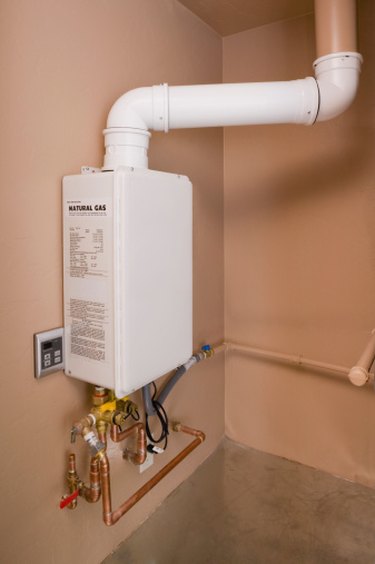
Modern hydronic heating systems have automatic water fill valves, and automatic air purge vents. However, draining part or all of your boiler system is often required during repairs. Water fill valves and automatic air purge vents are designed to maintain efficient operation during regular use. Manual operation of these is required to quickly fill and purge your hydronic heating system after a repair.
Step 1
Find the in-line circulating pump. It's a round device near the boiler, connected to the piping by two flanges. Both the pump and flanges will be painted identically, often red or green. Common pump manufacturers include Bell & Gossett, Taco and Grundfos.
Video of the Day
Step 2
Locate a directional arrow, cast into the pump flange, on the side opposite the pump motor. Note the direction of the arrow in relation to the piping of the boiler. If the arrow points toward the boiler, the pump is on the return side of the boiler. If the arrow points away from the boiler, the pump is on the supply side of the boiler. Most pumps are located on the return side.
Step 3
Find a valve similar to a garden hose spigot near the pump. Connect your garden hose to the valve. Place the other end of the garden hose into a floor drain. Alternately, if no floor drains are available, you can use a large bucket. The process will go considerably slower, as you will have to repeatedly dump out the bucket.
Step 4
Locate the water fill pipe, by following your main water line, until you get to the single, small diameter pipe leading directly to the boiler. Locate the brass, bell-shaped water fill valve. Locate the lever on top of the water fill valve. The lever is horizontal, or parallel to the floor, during normal operation. Lifting the lever vertically, or perpendicular to the floor operates the fast-fill feature.
Step 5
Use the lever to fast-fill the boiler, while simultaneously releasing water down the drain from the garden hose valve. Find a pattern where you allow pressure to build inside the boiler, then release the pressure quickly, taking air along with water down the drain.
Step 6
Listen to the system as you repeat the fill and purge cycle. You will hear the bubbling and gurgling associated with air in the system. As the air is purged, the system will return to normal quiet operation.
Tip
There are several ways to pipe a boiler, depending on home, space and personal requirements for the system. All systems, however, share many similarities in piping and operation. Once you understand the basic operation you will be able to identify the parts and components of a variety of hydronic heating systems.
Warning
The old adage that water and electricity do not mix holds true. In order to properly fill and purge a hydronic heating system you will be surrounded by operating electrical components of the boiler and a wet environment. To prevent equipment damage and personal injury, take time to familiarize yourself with the components and remain mindful of the water surrounding you.
Video of the Day